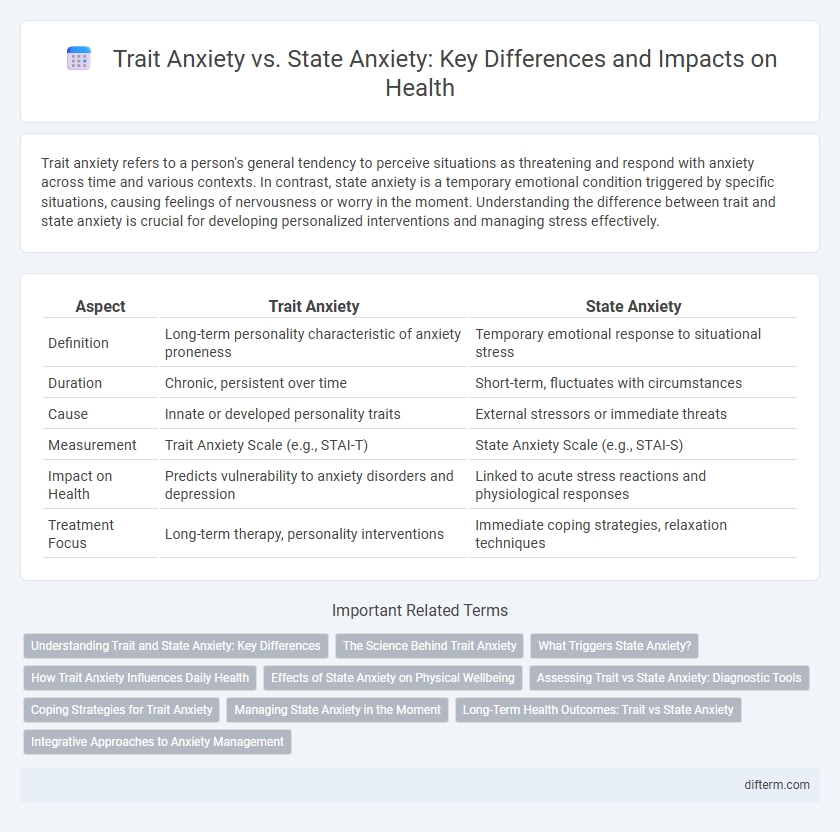Trait anxiety refers to a person's general tendency to perceive situations as threatening and respond with anxiety across time and various contexts. In contrast, state anxiety is a temporary emotional condition triggered by specific situations, causing feelings of nervousness or worry in the moment. Understanding the difference between trait and state anxiety is crucial for developing personalized interventions and managing stress effectively.
Table of Comparison
| Aspect | Trait Anxiety | State Anxiety |
|---|---|---|
| Definition | Long-term personality characteristic of anxiety proneness | Temporary emotional response to situational stress |
| Duration | Chronic, persistent over time | Short-term, fluctuates with circumstances |
| Cause | Innate or developed personality traits | External stressors or immediate threats |
| Measurement | Trait Anxiety Scale (e.g., STAI-T) | State Anxiety Scale (e.g., STAI-S) |
| Impact on Health | Predicts vulnerability to anxiety disorders and depression | Linked to acute stress reactions and physiological responses |
| Treatment Focus | Long-term therapy, personality interventions | Immediate coping strategies, relaxation techniques |
Understanding Trait and State Anxiety: Key Differences
Trait anxiety refers to a person's stable tendency to perceive situations as threatening and respond with anxiety across various contexts, reflecting a consistent personality characteristic. State anxiety, in contrast, is a temporary emotional condition triggered by specific situations, characterized by heightened nervousness or tension that fluctuates over time. Recognizing these differences is crucial for targeted interventions, as trait anxiety influences long-term mental health risks while state anxiety relates to immediate stress reactions.
The Science Behind Trait Anxiety
Trait anxiety is a stable personality characteristic involving a consistent tendency to perceive situations as threatening, leading to chronic stress responses. Neuroscientific research links trait anxiety to hyperactivity in the amygdala and dysregulation of the hypothalamic-pituitary-adrenal (HPA) axis, which heightens cortisol production. Genetic factors and early life stress contribute to the development of trait anxiety by influencing brain structures and neurotransmitter systems responsible for emotional regulation.
What Triggers State Anxiety?
State anxiety is triggered by specific, immediate stressors such as public speaking, exams, or threatening situations, causing temporary feelings of nervousness and heightened arousal. Unlike trait anxiety, which is a stable personality characteristic, state anxiety fluctuates in intensity based on external events and perceived threats. Situations involving uncertainty, potential evaluation, or physical danger commonly activate state anxiety responses.
How Trait Anxiety Influences Daily Health
Trait anxiety, characterized by a stable tendency to perceive situations as threatening, significantly impacts daily health by increasing chronic stress levels and impairing immune function. Individuals with high trait anxiety often experience persistent muscle tension, disrupted sleep patterns, and heightened cardiovascular risk, which cumulatively contribute to long-term health complications. Managing trait anxiety through cognitive-behavioral interventions and mindfulness can mitigate its adverse effects on physical and mental well-being.
Effects of State Anxiety on Physical Wellbeing
State anxiety triggers immediate physiological responses such as increased heart rate, muscle tension, and elevated cortisol levels, which can strain cardiovascular health and immune function. These acute stress reactions often lead to symptoms like headaches, gastrointestinal disturbances, and fatigue, impacting overall physical wellbeing. Prolonged episodes of state anxiety may exacerbate chronic conditions and hinder recovery due to sustained activation of the body's stress system.
Assessing Trait vs State Anxiety: Diagnostic Tools
Assessing trait anxiety versus state anxiety requires specific diagnostic tools designed to measure either the stable predisposition to anxiety (trait) or temporary emotional responses (state). The State-Trait Anxiety Inventory (STAI) is widely recognized for differentiating between these forms by utilizing separate subscales to quantify long-term anxiety tendencies and current anxiety levels. Clinical assessments often incorporate physiological measures, such as heart rate variability and cortisol levels, alongside self-report questionnaires to provide a comprehensive evaluation of both trait and state anxiety.
Coping Strategies for Trait Anxiety
Trait anxiety, a stable personality characteristic reflecting a tendency to perceive situations as threatening, requires long-term coping strategies such as cognitive-behavioral therapy (CBT) to restructure negative thought patterns. Mindfulness-based stress reduction (MBSR) and regular physical exercise help modulate physiological responses and improve emotional regulation. Consistent practice of relaxation techniques like deep breathing or progressive muscle relaxation supports individuals in managing trait anxiety symptoms effectively over time.
Managing State Anxiety in the Moment
State anxiety refers to the temporary emotional and physiological response to a specific stressor, characterized by increased heart rate, sweating, and nervousness. Effective management techniques include deep breathing exercises, grounding techniques, and mindfulness meditation, which help reduce immediate symptoms and promote relaxation. Implementing these strategies in moments of acute stress can prevent escalation and improve overall emotional regulation.
Long-Term Health Outcomes: Trait vs State Anxiety
Trait anxiety, characterized by a stable tendency to perceive situations as threatening, is linked to chronic health issues such as cardiovascular disease and impaired immune function. State anxiety, a temporary emotional response to specific stressors, may exacerbate symptoms but does not typically cause long-term health problems. Understanding the distinction helps in tailoring interventions to reduce persistent anxiety and improve long-term health outcomes.
Integrative Approaches to Anxiety Management
Integrative approaches to anxiety management address both trait anxiety, the chronic predisposition to anxiety, and state anxiety, the temporary response to stressors, through a combination of cognitive-behavioral therapy, mindfulness-based stress reduction, and pharmacological interventions. Techniques such as biofeedback and yoga enhance autonomic regulation, reducing physiological symptoms associated with both anxiety types. Personalized treatment plans incorporating lifestyle changes, nutritional support, and psychotherapy have shown efficacy in lowering overall anxiety levels and improving quality of life.
trait anxiety vs state anxiety Infographic

 difterm.com
difterm.com